BUSM7938C Risk Assessment Plan Report: Buttercup Button Company
VerifiedAdded on 2023/01/11
|19
|4465
|63
Report
AI Summary
This report presents a comprehensive risk assessment plan for Buttercup Button Company, focusing on sustainability policy recommendations to senior management. The report begins with an introduction to risk assessment and its importance in organizations, followed by an analysis of the current context, including existing risk management policies and their strengths and weaknesses. The report identifies the risks associated with the company's manufacturing processes, particularly those related to machinery and hazardous materials. The proposed actions include implementing a sustainability policy to reduce injuries and increase waste recycling, along with the benefits for stakeholders, including employees, the company, and the environment. The plan outlines the resources, personnel, and procedures involved in developing, implementing, and monitoring the improvements, including performance measures and benchmarking strategies. The report also addresses compliance with environmental legislation and Codes of Practice. The report concludes with a discussion of the expected outcomes and the support information, offering a detailed plan to mitigate risks and promote a safer, more sustainable workplace. The report emphasizes the need for the company to follow Australian standards to provide security and to maintain health and safety standard at the workplace as per the Australian standard.
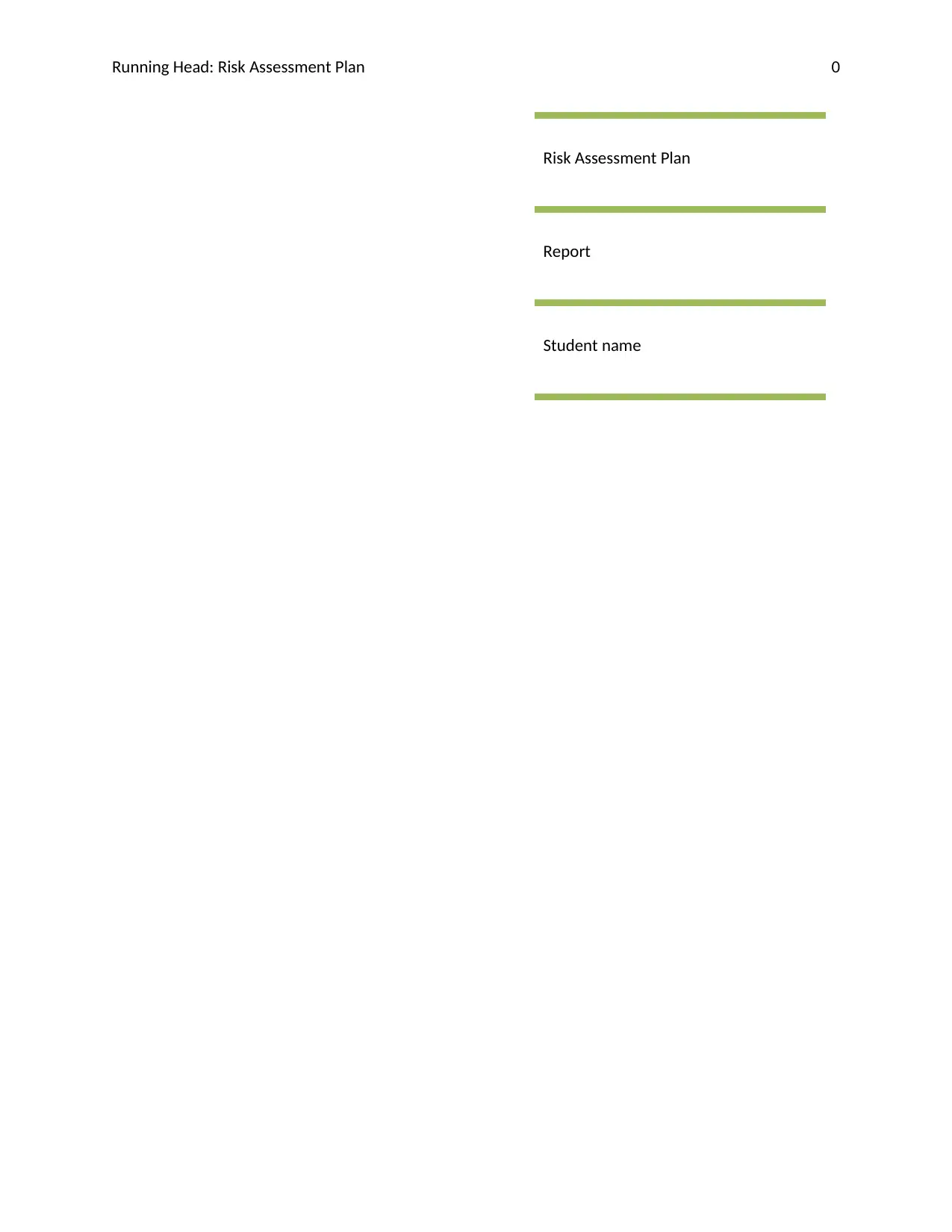
Running Head: Risk Assessment Plan 0
Risk Assessment Plan
Report
Student name
Risk Assessment Plan
Report
Student name
Paraphrase This Document
Need a fresh take? Get an instant paraphrase of this document with our AI Paraphraser
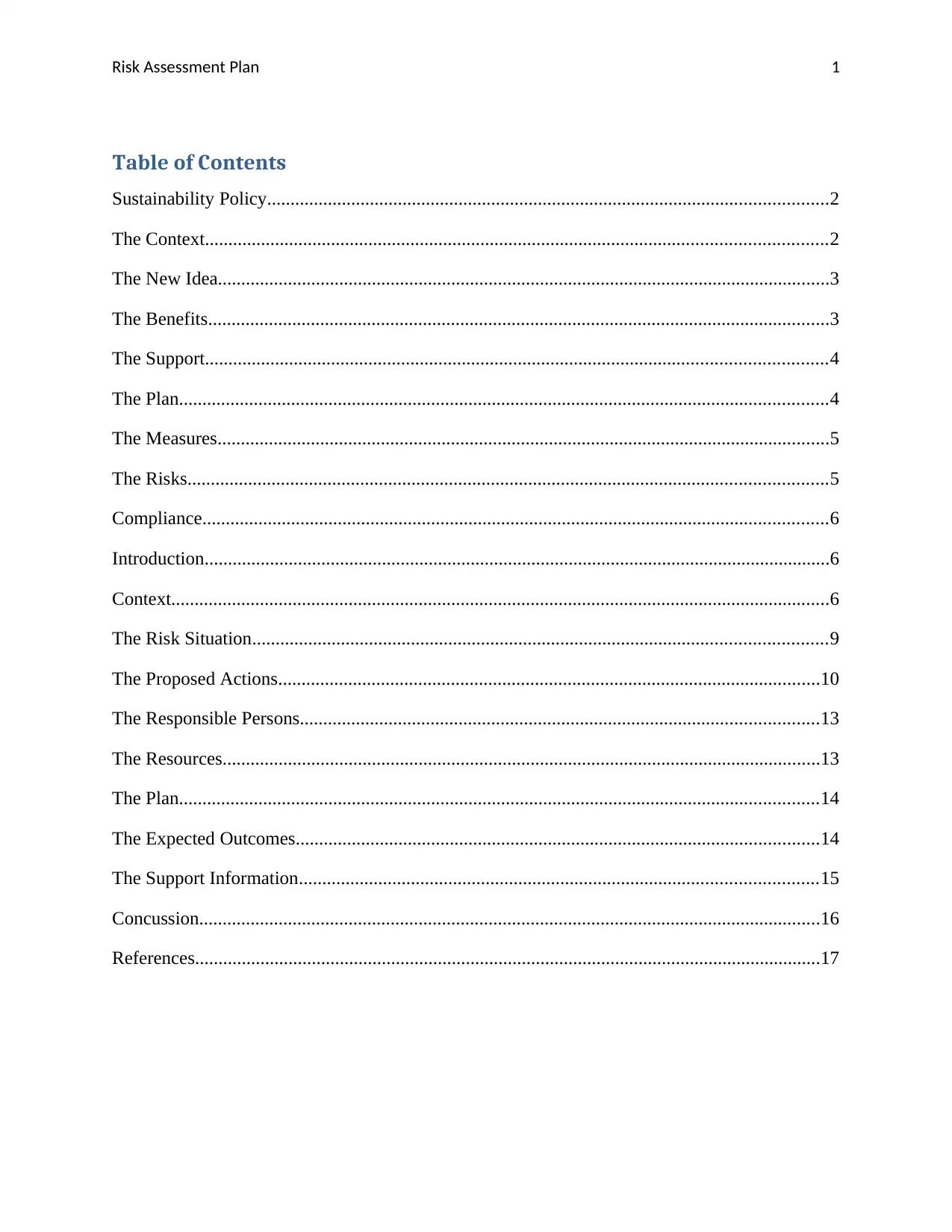
Risk Assessment Plan 1
Table of Contents
Sustainability Policy........................................................................................................................2
The Context.....................................................................................................................................2
The New Idea...................................................................................................................................3
The Benefits.....................................................................................................................................3
The Support.....................................................................................................................................4
The Plan...........................................................................................................................................4
The Measures...................................................................................................................................5
The Risks.........................................................................................................................................5
Compliance......................................................................................................................................6
Introduction......................................................................................................................................6
Context.............................................................................................................................................6
The Risk Situation...........................................................................................................................9
The Proposed Actions....................................................................................................................10
The Responsible Persons...............................................................................................................13
The Resources................................................................................................................................13
The Plan.........................................................................................................................................14
The Expected Outcomes................................................................................................................14
The Support Information...............................................................................................................15
Concussion.....................................................................................................................................16
References......................................................................................................................................17
Table of Contents
Sustainability Policy........................................................................................................................2
The Context.....................................................................................................................................2
The New Idea...................................................................................................................................3
The Benefits.....................................................................................................................................3
The Support.....................................................................................................................................4
The Plan...........................................................................................................................................4
The Measures...................................................................................................................................5
The Risks.........................................................................................................................................5
Compliance......................................................................................................................................6
Introduction......................................................................................................................................6
Context.............................................................................................................................................6
The Risk Situation...........................................................................................................................9
The Proposed Actions....................................................................................................................10
The Responsible Persons...............................................................................................................13
The Resources................................................................................................................................13
The Plan.........................................................................................................................................14
The Expected Outcomes................................................................................................................14
The Support Information...............................................................................................................15
Concussion.....................................................................................................................................16
References......................................................................................................................................17
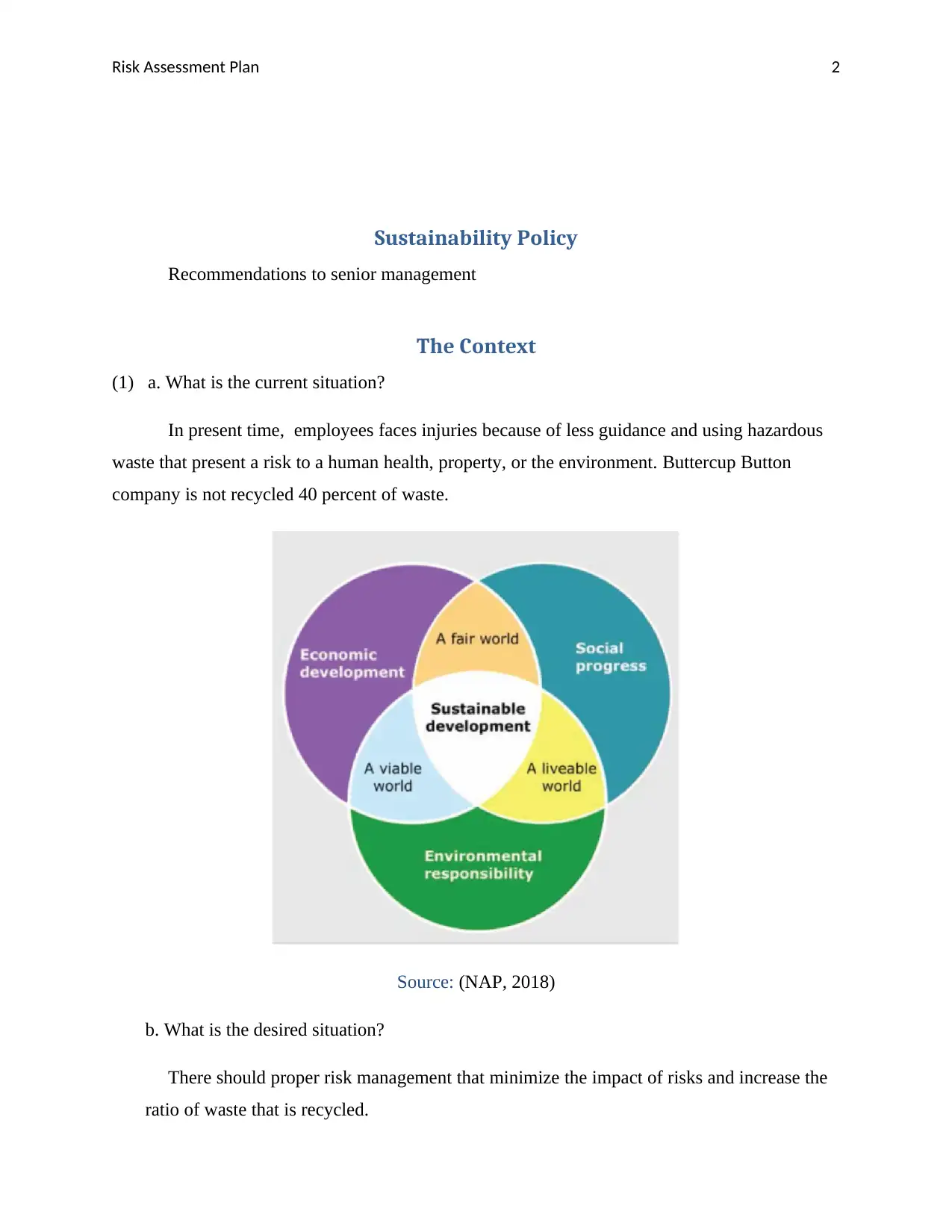
Risk Assessment Plan 2
Sustainability Policy
Recommendations to senior management
The Context
(1) a. What is the current situation?
In present time, employees faces injuries because of less guidance and using hazardous
waste that present a risk to a human health, property, or the environment. Buttercup Button
company is not recycled 40 percent of waste.
Source: (NAP, 2018)
b. What is the desired situation?
There should proper risk management that minimize the impact of risks and increase the
ratio of waste that is recycled.
Sustainability Policy
Recommendations to senior management
The Context
(1) a. What is the current situation?
In present time, employees faces injuries because of less guidance and using hazardous
waste that present a risk to a human health, property, or the environment. Buttercup Button
company is not recycled 40 percent of waste.
Source: (NAP, 2018)
b. What is the desired situation?
There should proper risk management that minimize the impact of risks and increase the
ratio of waste that is recycled.
⊘ This is a preview!⊘
Do you want full access?
Subscribe today to unlock all pages.

Trusted by 1+ million students worldwide
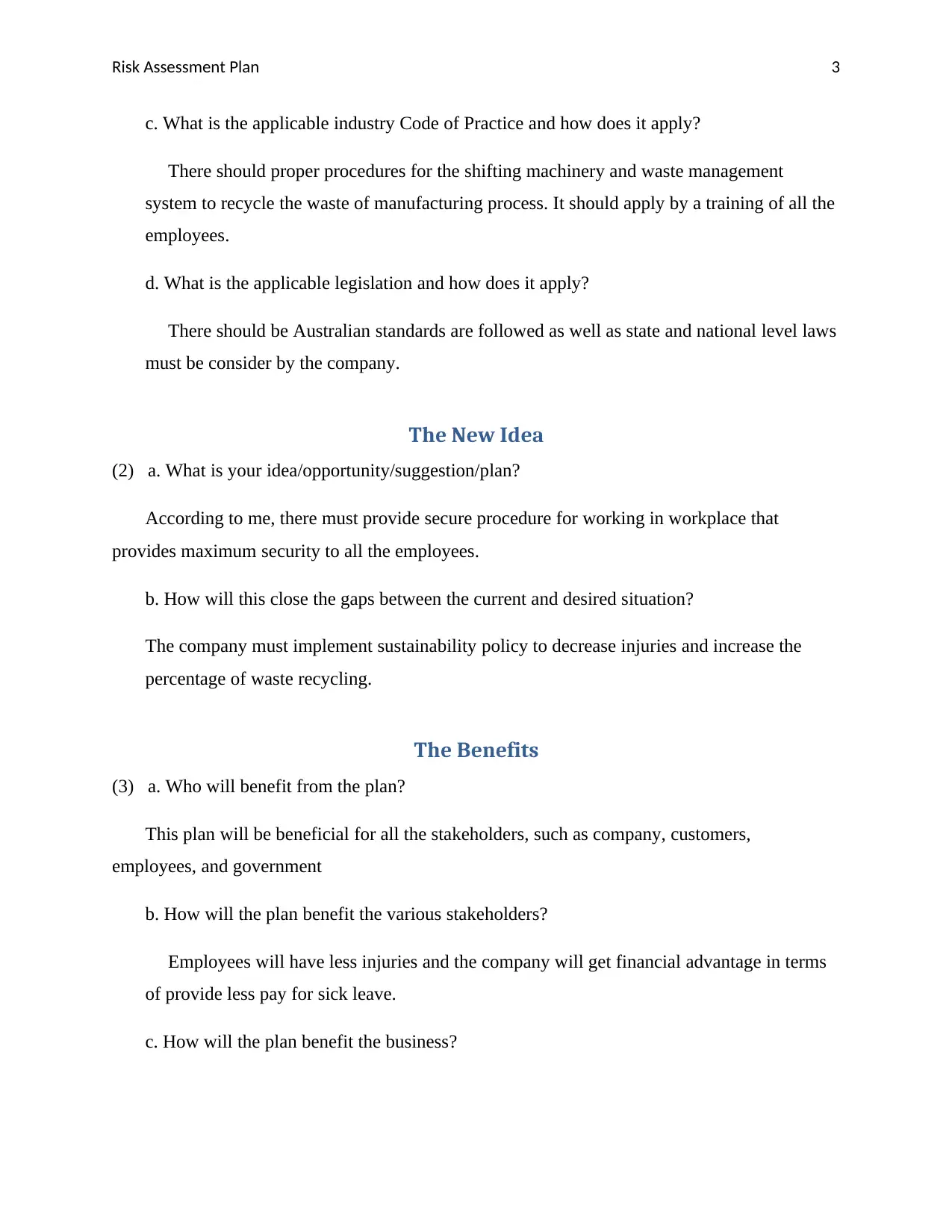
Risk Assessment Plan 3
c. What is the applicable industry Code of Practice and how does it apply?
There should proper procedures for the shifting machinery and waste management
system to recycle the waste of manufacturing process. It should apply by a training of all the
employees.
d. What is the applicable legislation and how does it apply?
There should be Australian standards are followed as well as state and national level laws
must be consider by the company.
The New Idea
(2) a. What is your idea/opportunity/suggestion/plan?
According to me, there must provide secure procedure for working in workplace that
provides maximum security to all the employees.
b. How will this close the gaps between the current and desired situation?
The company must implement sustainability policy to decrease injuries and increase the
percentage of waste recycling.
The Benefits
(3) a. Who will benefit from the plan?
This plan will be beneficial for all the stakeholders, such as company, customers,
employees, and government
b. How will the plan benefit the various stakeholders?
Employees will have less injuries and the company will get financial advantage in terms
of provide less pay for sick leave.
c. How will the plan benefit the business?
c. What is the applicable industry Code of Practice and how does it apply?
There should proper procedures for the shifting machinery and waste management
system to recycle the waste of manufacturing process. It should apply by a training of all the
employees.
d. What is the applicable legislation and how does it apply?
There should be Australian standards are followed as well as state and national level laws
must be consider by the company.
The New Idea
(2) a. What is your idea/opportunity/suggestion/plan?
According to me, there must provide secure procedure for working in workplace that
provides maximum security to all the employees.
b. How will this close the gaps between the current and desired situation?
The company must implement sustainability policy to decrease injuries and increase the
percentage of waste recycling.
The Benefits
(3) a. Who will benefit from the plan?
This plan will be beneficial for all the stakeholders, such as company, customers,
employees, and government
b. How will the plan benefit the various stakeholders?
Employees will have less injuries and the company will get financial advantage in terms
of provide less pay for sick leave.
c. How will the plan benefit the business?
Paraphrase This Document
Need a fresh take? Get an instant paraphrase of this document with our AI Paraphraser
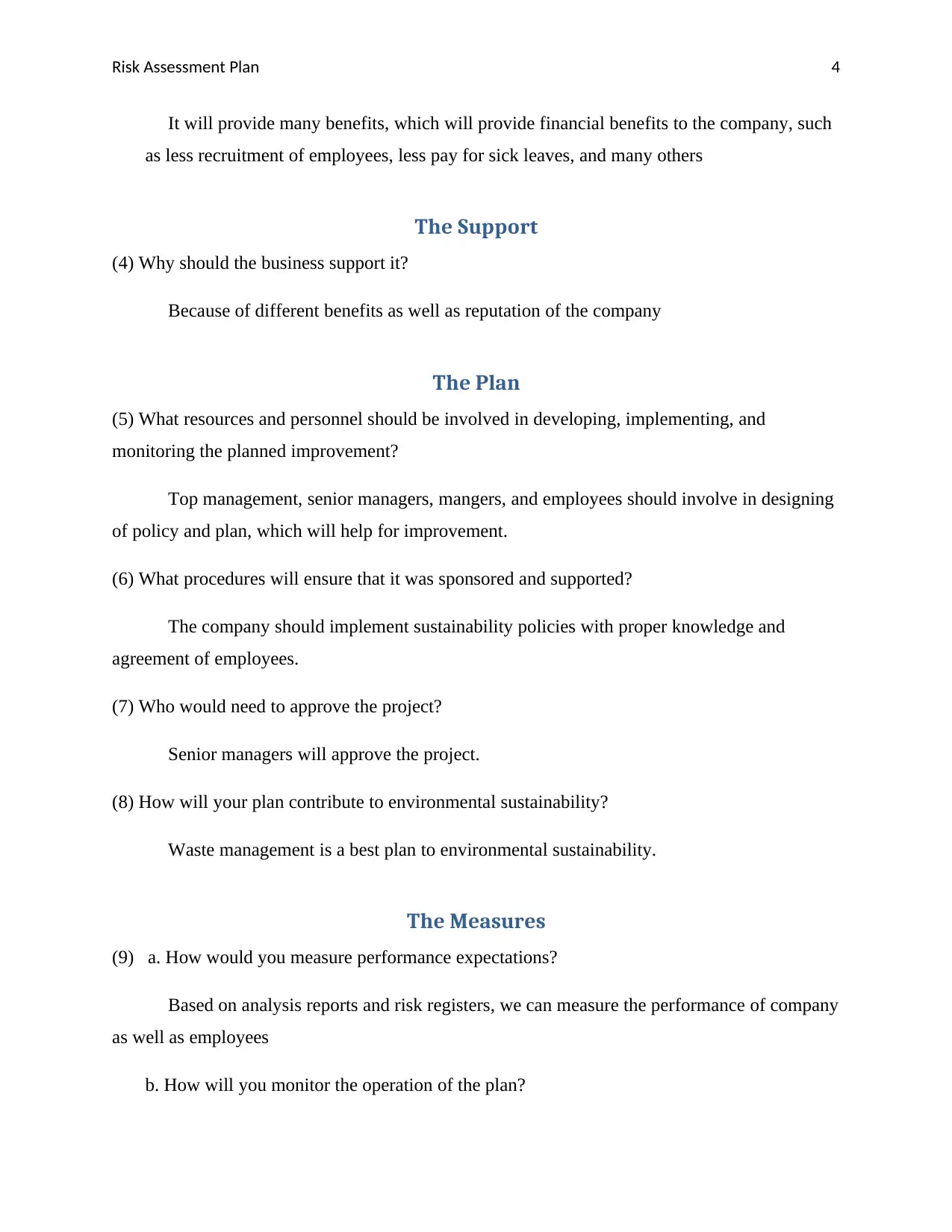
Risk Assessment Plan 4
It will provide many benefits, which will provide financial benefits to the company, such
as less recruitment of employees, less pay for sick leaves, and many others
The Support
(4) Why should the business support it?
Because of different benefits as well as reputation of the company
The Plan
(5) What resources and personnel should be involved in developing, implementing, and
monitoring the planned improvement?
Top management, senior managers, mangers, and employees should involve in designing
of policy and plan, which will help for improvement.
(6) What procedures will ensure that it was sponsored and supported?
The company should implement sustainability policies with proper knowledge and
agreement of employees.
(7) Who would need to approve the project?
Senior managers will approve the project.
(8) How will your plan contribute to environmental sustainability?
Waste management is a best plan to environmental sustainability.
The Measures
(9) a. How would you measure performance expectations?
Based on analysis reports and risk registers, we can measure the performance of company
as well as employees
b. How will you monitor the operation of the plan?
It will provide many benefits, which will provide financial benefits to the company, such
as less recruitment of employees, less pay for sick leaves, and many others
The Support
(4) Why should the business support it?
Because of different benefits as well as reputation of the company
The Plan
(5) What resources and personnel should be involved in developing, implementing, and
monitoring the planned improvement?
Top management, senior managers, mangers, and employees should involve in designing
of policy and plan, which will help for improvement.
(6) What procedures will ensure that it was sponsored and supported?
The company should implement sustainability policies with proper knowledge and
agreement of employees.
(7) Who would need to approve the project?
Senior managers will approve the project.
(8) How will your plan contribute to environmental sustainability?
Waste management is a best plan to environmental sustainability.
The Measures
(9) a. How would you measure performance expectations?
Based on analysis reports and risk registers, we can measure the performance of company
as well as employees
b. How will you monitor the operation of the plan?
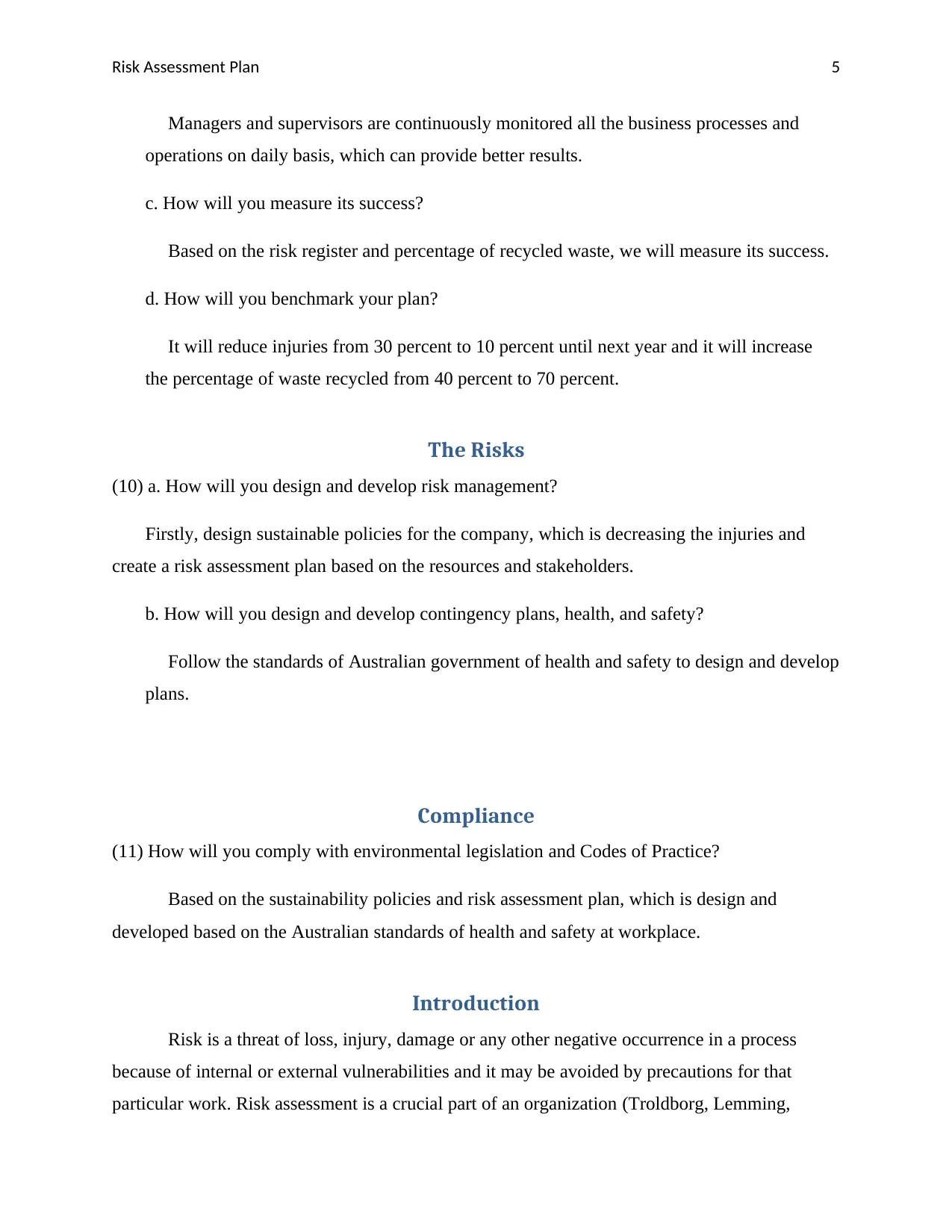
Risk Assessment Plan 5
Managers and supervisors are continuously monitored all the business processes and
operations on daily basis, which can provide better results.
c. How will you measure its success?
Based on the risk register and percentage of recycled waste, we will measure its success.
d. How will you benchmark your plan?
It will reduce injuries from 30 percent to 10 percent until next year and it will increase
the percentage of waste recycled from 40 percent to 70 percent.
The Risks
(10) a. How will you design and develop risk management?
Firstly, design sustainable policies for the company, which is decreasing the injuries and
create a risk assessment plan based on the resources and stakeholders.
b. How will you design and develop contingency plans, health, and safety?
Follow the standards of Australian government of health and safety to design and develop
plans.
Compliance
(11) How will you comply with environmental legislation and Codes of Practice?
Based on the sustainability policies and risk assessment plan, which is design and
developed based on the Australian standards of health and safety at workplace.
Introduction
Risk is a threat of loss, injury, damage or any other negative occurrence in a process
because of internal or external vulnerabilities and it may be avoided by precautions for that
particular work. Risk assessment is a crucial part of an organization (Troldborg, Lemming,
Managers and supervisors are continuously monitored all the business processes and
operations on daily basis, which can provide better results.
c. How will you measure its success?
Based on the risk register and percentage of recycled waste, we will measure its success.
d. How will you benchmark your plan?
It will reduce injuries from 30 percent to 10 percent until next year and it will increase
the percentage of waste recycled from 40 percent to 70 percent.
The Risks
(10) a. How will you design and develop risk management?
Firstly, design sustainable policies for the company, which is decreasing the injuries and
create a risk assessment plan based on the resources and stakeholders.
b. How will you design and develop contingency plans, health, and safety?
Follow the standards of Australian government of health and safety to design and develop
plans.
Compliance
(11) How will you comply with environmental legislation and Codes of Practice?
Based on the sustainability policies and risk assessment plan, which is design and
developed based on the Australian standards of health and safety at workplace.
Introduction
Risk is a threat of loss, injury, damage or any other negative occurrence in a process
because of internal or external vulnerabilities and it may be avoided by precautions for that
particular work. Risk assessment is a crucial part of an organization (Troldborg, Lemming,
⊘ This is a preview!⊘
Do you want full access?
Subscribe today to unlock all pages.

Trusted by 1+ million students worldwide
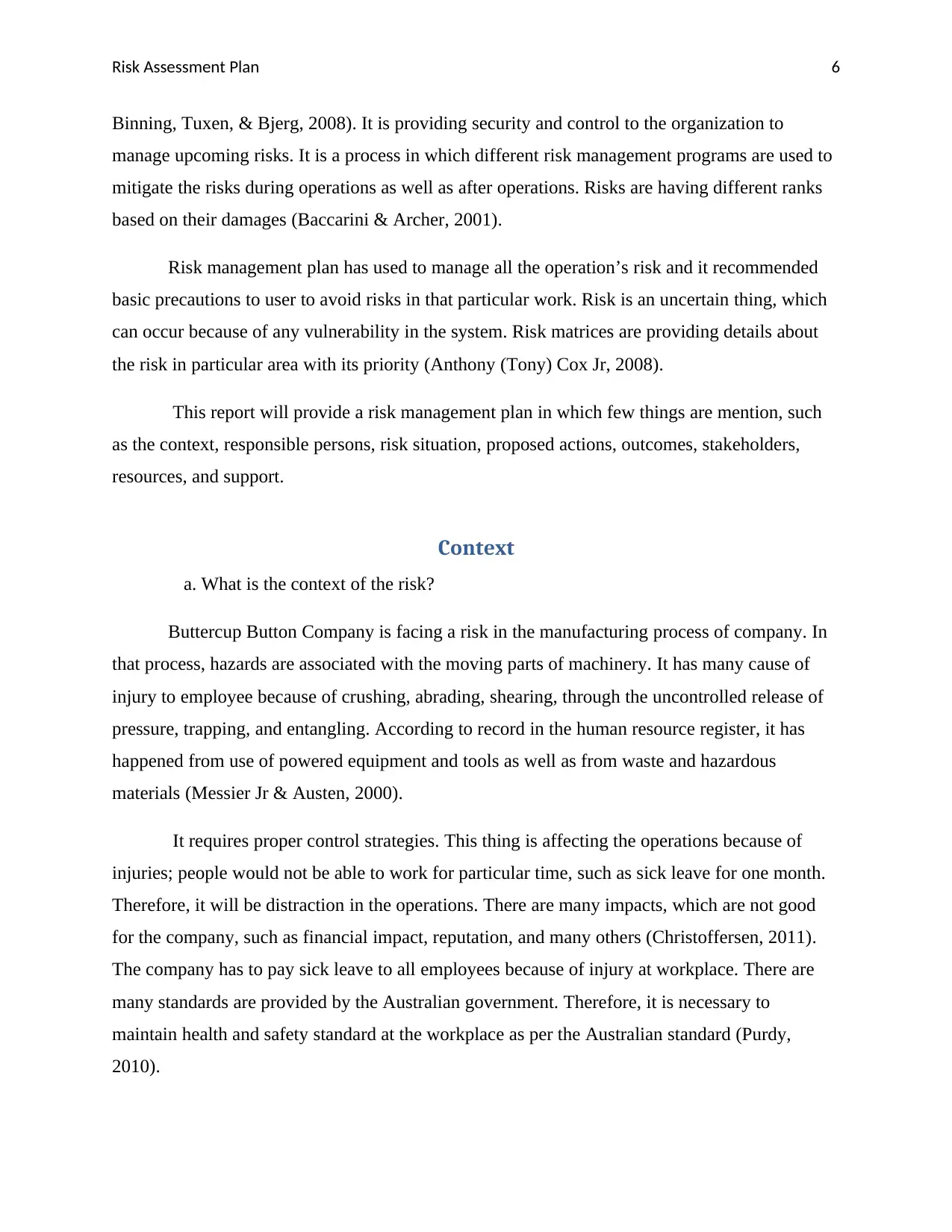
Risk Assessment Plan 6
Binning, Tuxen, & Bjerg, 2008). It is providing security and control to the organization to
manage upcoming risks. It is a process in which different risk management programs are used to
mitigate the risks during operations as well as after operations. Risks are having different ranks
based on their damages (Baccarini & Archer, 2001).
Risk management plan has used to manage all the operation’s risk and it recommended
basic precautions to user to avoid risks in that particular work. Risk is an uncertain thing, which
can occur because of any vulnerability in the system. Risk matrices are providing details about
the risk in particular area with its priority (Anthony (Tony) Cox Jr, 2008).
This report will provide a risk management plan in which few things are mention, such
as the context, responsible persons, risk situation, proposed actions, outcomes, stakeholders,
resources, and support.
Context
a. What is the context of the risk?
Buttercup Button Company is facing a risk in the manufacturing process of company. In
that process, hazards are associated with the moving parts of machinery. It has many cause of
injury to employee because of crushing, abrading, shearing, through the uncontrolled release of
pressure, trapping, and entangling. According to record in the human resource register, it has
happened from use of powered equipment and tools as well as from waste and hazardous
materials (Messier Jr & Austen, 2000).
It requires proper control strategies. This thing is affecting the operations because of
injuries; people would not be able to work for particular time, such as sick leave for one month.
Therefore, it will be distraction in the operations. There are many impacts, which are not good
for the company, such as financial impact, reputation, and many others (Christoffersen, 2011).
The company has to pay sick leave to all employees because of injury at workplace. There are
many standards are provided by the Australian government. Therefore, it is necessary to
maintain health and safety standard at the workplace as per the Australian standard (Purdy,
2010).
Binning, Tuxen, & Bjerg, 2008). It is providing security and control to the organization to
manage upcoming risks. It is a process in which different risk management programs are used to
mitigate the risks during operations as well as after operations. Risks are having different ranks
based on their damages (Baccarini & Archer, 2001).
Risk management plan has used to manage all the operation’s risk and it recommended
basic precautions to user to avoid risks in that particular work. Risk is an uncertain thing, which
can occur because of any vulnerability in the system. Risk matrices are providing details about
the risk in particular area with its priority (Anthony (Tony) Cox Jr, 2008).
This report will provide a risk management plan in which few things are mention, such
as the context, responsible persons, risk situation, proposed actions, outcomes, stakeholders,
resources, and support.
Context
a. What is the context of the risk?
Buttercup Button Company is facing a risk in the manufacturing process of company. In
that process, hazards are associated with the moving parts of machinery. It has many cause of
injury to employee because of crushing, abrading, shearing, through the uncontrolled release of
pressure, trapping, and entangling. According to record in the human resource register, it has
happened from use of powered equipment and tools as well as from waste and hazardous
materials (Messier Jr & Austen, 2000).
It requires proper control strategies. This thing is affecting the operations because of
injuries; people would not be able to work for particular time, such as sick leave for one month.
Therefore, it will be distraction in the operations. There are many impacts, which are not good
for the company, such as financial impact, reputation, and many others (Christoffersen, 2011).
The company has to pay sick leave to all employees because of injury at workplace. There are
many standards are provided by the Australian government. Therefore, it is necessary to
maintain health and safety standard at the workplace as per the Australian standard (Purdy,
2010).
Paraphrase This Document
Need a fresh take? Get an instant paraphrase of this document with our AI Paraphraser
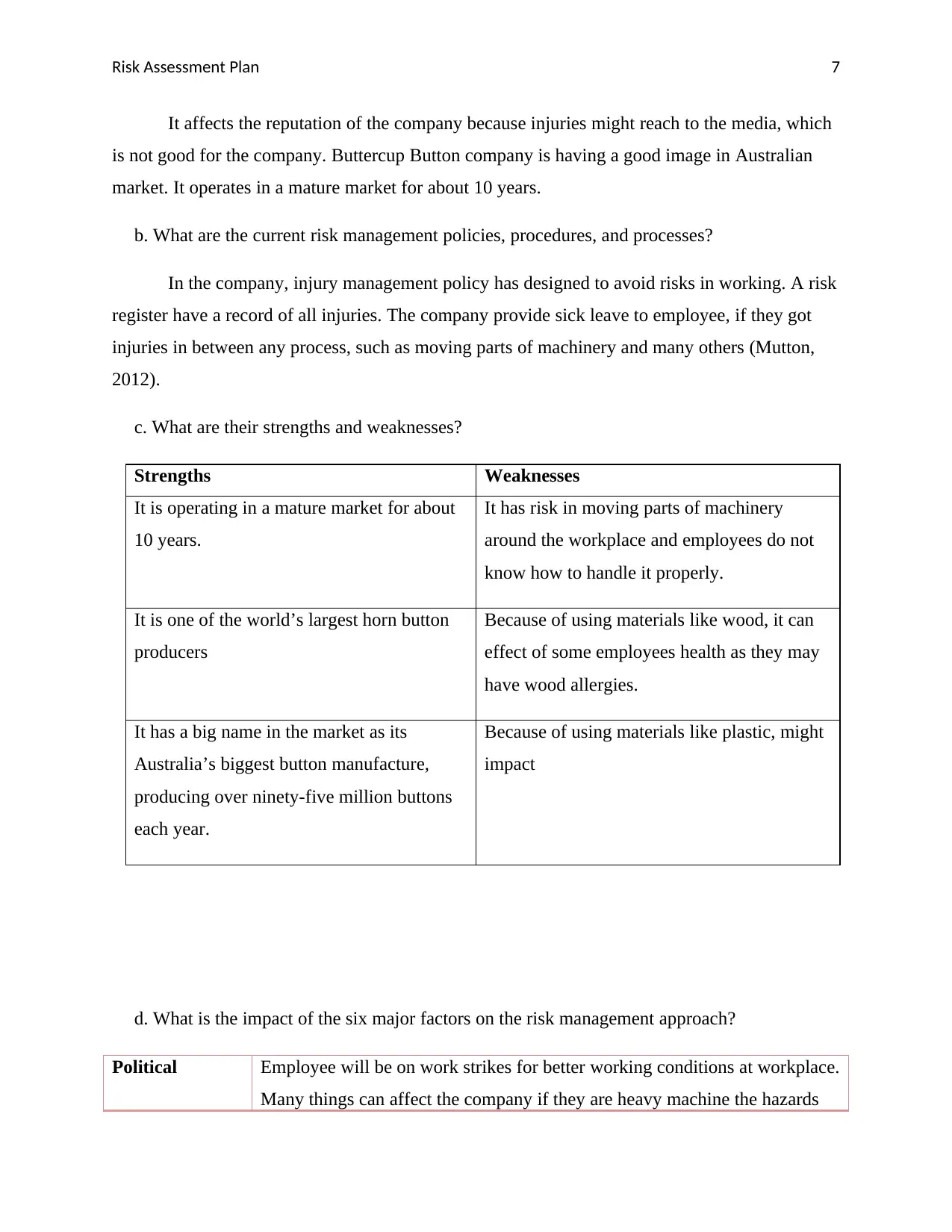
Risk Assessment Plan 7
It affects the reputation of the company because injuries might reach to the media, which
is not good for the company. Buttercup Button company is having a good image in Australian
market. It operates in a mature market for about 10 years.
b. What are the current risk management policies, procedures, and processes?
In the company, injury management policy has designed to avoid risks in working. A risk
register have a record of all injuries. The company provide sick leave to employee, if they got
injuries in between any process, such as moving parts of machinery and many others (Mutton,
2012).
c. What are their strengths and weaknesses?
Strengths Weaknesses
It is operating in a mature market for about
10 years.
It has risk in moving parts of machinery
around the workplace and employees do not
know how to handle it properly.
It is one of the world’s largest horn button
producers
Because of using materials like wood, it can
effect of some employees health as they may
have wood allergies.
It has a big name in the market as its
Australia’s biggest button manufacture,
producing over ninety-five million buttons
each year.
Because of using materials like plastic, might
impact
d. What is the impact of the six major factors on the risk management approach?
Political Employee will be on work strikes for better working conditions at workplace.
Many things can affect the company if they are heavy machine the hazards
It affects the reputation of the company because injuries might reach to the media, which
is not good for the company. Buttercup Button company is having a good image in Australian
market. It operates in a mature market for about 10 years.
b. What are the current risk management policies, procedures, and processes?
In the company, injury management policy has designed to avoid risks in working. A risk
register have a record of all injuries. The company provide sick leave to employee, if they got
injuries in between any process, such as moving parts of machinery and many others (Mutton,
2012).
c. What are their strengths and weaknesses?
Strengths Weaknesses
It is operating in a mature market for about
10 years.
It has risk in moving parts of machinery
around the workplace and employees do not
know how to handle it properly.
It is one of the world’s largest horn button
producers
Because of using materials like wood, it can
effect of some employees health as they may
have wood allergies.
It has a big name in the market as its
Australia’s biggest button manufacture,
producing over ninety-five million buttons
each year.
Because of using materials like plastic, might
impact
d. What is the impact of the six major factors on the risk management approach?
Political Employee will be on work strikes for better working conditions at workplace.
Many things can affect the company if they are heavy machine the hazards
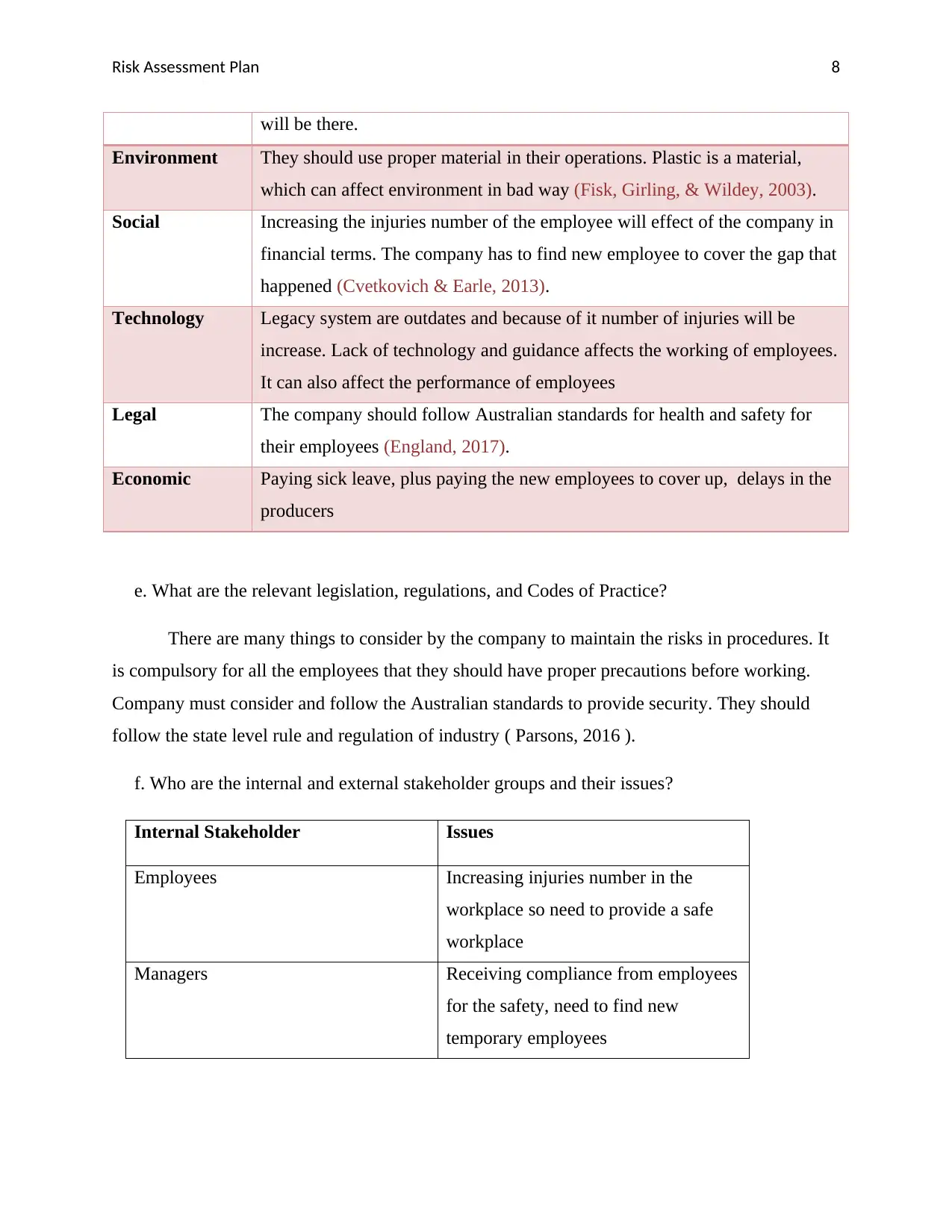
Risk Assessment Plan 8
will be there.
Environment They should use proper material in their operations. Plastic is a material,
which can affect environment in bad way (Fisk, Girling, & Wildey, 2003).
Social Increasing the injuries number of the employee will effect of the company in
financial terms. The company has to find new employee to cover the gap that
happened (Cvetkovich & Earle, 2013).
Technology Legacy system are outdates and because of it number of injuries will be
increase. Lack of technology and guidance affects the working of employees.
It can also affect the performance of employees
Legal The company should follow Australian standards for health and safety for
their employees (England, 2017).
Economic Paying sick leave, plus paying the new employees to cover up, delays in the
producers
e. What are the relevant legislation, regulations, and Codes of Practice?
There are many things to consider by the company to maintain the risks in procedures. It
is compulsory for all the employees that they should have proper precautions before working.
Company must consider and follow the Australian standards to provide security. They should
follow the state level rule and regulation of industry ( Parsons, 2016 ).
f. Who are the internal and external stakeholder groups and their issues?
Internal Stakeholder Issues
Employees Increasing injuries number in the
workplace so need to provide a safe
workplace
Managers Receiving compliance from employees
for the safety, need to find new
temporary employees
will be there.
Environment They should use proper material in their operations. Plastic is a material,
which can affect environment in bad way (Fisk, Girling, & Wildey, 2003).
Social Increasing the injuries number of the employee will effect of the company in
financial terms. The company has to find new employee to cover the gap that
happened (Cvetkovich & Earle, 2013).
Technology Legacy system are outdates and because of it number of injuries will be
increase. Lack of technology and guidance affects the working of employees.
It can also affect the performance of employees
Legal The company should follow Australian standards for health and safety for
their employees (England, 2017).
Economic Paying sick leave, plus paying the new employees to cover up, delays in the
producers
e. What are the relevant legislation, regulations, and Codes of Practice?
There are many things to consider by the company to maintain the risks in procedures. It
is compulsory for all the employees that they should have proper precautions before working.
Company must consider and follow the Australian standards to provide security. They should
follow the state level rule and regulation of industry ( Parsons, 2016 ).
f. Who are the internal and external stakeholder groups and their issues?
Internal Stakeholder Issues
Employees Increasing injuries number in the
workplace so need to provide a safe
workplace
Managers Receiving compliance from employees
for the safety, need to find new
temporary employees
⊘ This is a preview!⊘
Do you want full access?
Subscribe today to unlock all pages.

Trusted by 1+ million students worldwide
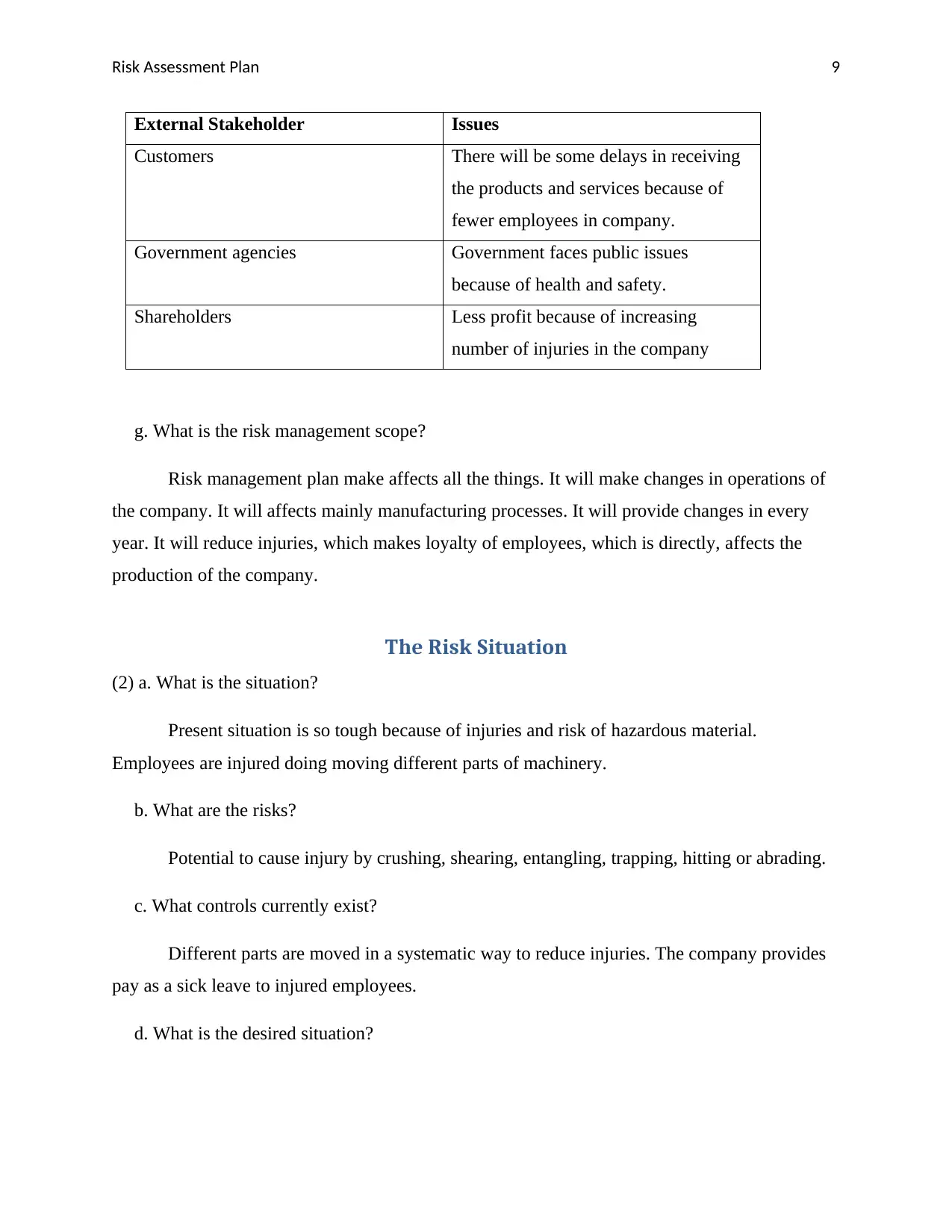
Risk Assessment Plan 9
External Stakeholder Issues
Customers There will be some delays in receiving
the products and services because of
fewer employees in company.
Government agencies Government faces public issues
because of health and safety.
Shareholders Less profit because of increasing
number of injuries in the company
g. What is the risk management scope?
Risk management plan make affects all the things. It will make changes in operations of
the company. It will affects mainly manufacturing processes. It will provide changes in every
year. It will reduce injuries, which makes loyalty of employees, which is directly, affects the
production of the company.
The Risk Situation
(2) a. What is the situation?
Present situation is so tough because of injuries and risk of hazardous material.
Employees are injured doing moving different parts of machinery.
b. What are the risks?
Potential to cause injury by crushing, shearing, entangling, trapping, hitting or abrading.
c. What controls currently exist?
Different parts are moved in a systematic way to reduce injuries. The company provides
pay as a sick leave to injured employees.
d. What is the desired situation?
External Stakeholder Issues
Customers There will be some delays in receiving
the products and services because of
fewer employees in company.
Government agencies Government faces public issues
because of health and safety.
Shareholders Less profit because of increasing
number of injuries in the company
g. What is the risk management scope?
Risk management plan make affects all the things. It will make changes in operations of
the company. It will affects mainly manufacturing processes. It will provide changes in every
year. It will reduce injuries, which makes loyalty of employees, which is directly, affects the
production of the company.
The Risk Situation
(2) a. What is the situation?
Present situation is so tough because of injuries and risk of hazardous material.
Employees are injured doing moving different parts of machinery.
b. What are the risks?
Potential to cause injury by crushing, shearing, entangling, trapping, hitting or abrading.
c. What controls currently exist?
Different parts are moved in a systematic way to reduce injuries. The company provides
pay as a sick leave to injured employees.
d. What is the desired situation?
Paraphrase This Document
Need a fresh take? Get an instant paraphrase of this document with our AI Paraphraser
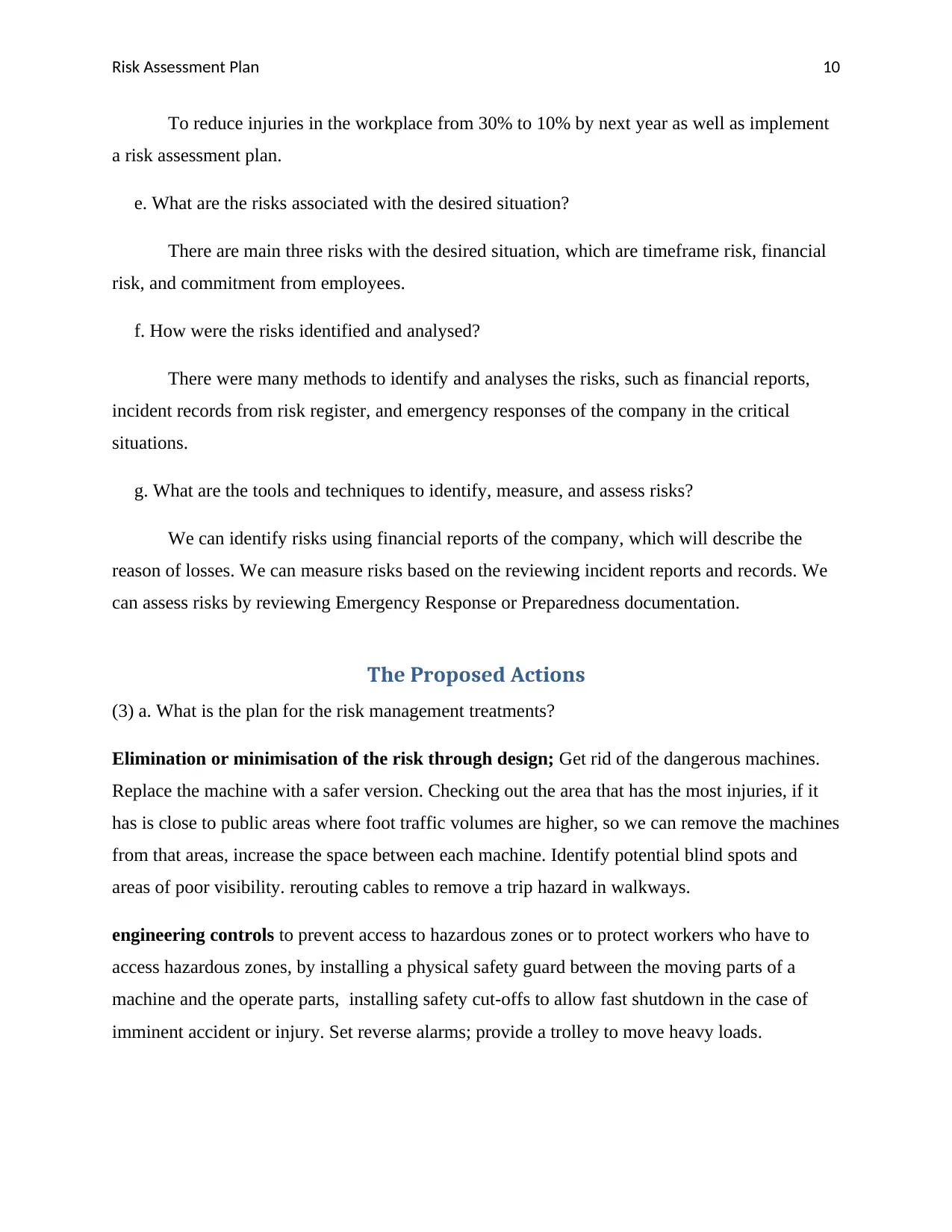
Risk Assessment Plan 10
To reduce injuries in the workplace from 30% to 10% by next year as well as implement
a risk assessment plan.
e. What are the risks associated with the desired situation?
There are main three risks with the desired situation, which are timeframe risk, financial
risk, and commitment from employees.
f. How were the risks identified and analysed?
There were many methods to identify and analyses the risks, such as financial reports,
incident records from risk register, and emergency responses of the company in the critical
situations.
g. What are the tools and techniques to identify, measure, and assess risks?
We can identify risks using financial reports of the company, which will describe the
reason of losses. We can measure risks based on the reviewing incident reports and records. We
can assess risks by reviewing Emergency Response or Preparedness documentation.
The Proposed Actions
(3) a. What is the plan for the risk management treatments?
Elimination or minimisation of the risk through design; Get rid of the dangerous machines.
Replace the machine with a safer version. Checking out the area that has the most injuries, if it
has is close to public areas where foot traffic volumes are higher, so we can remove the machines
from that areas, increase the space between each machine. Identify potential blind spots and
areas of poor visibility. rerouting cables to remove a trip hazard in walkways.
engineering controls to prevent access to hazardous zones or to protect workers who have to
access hazardous zones, by installing a physical safety guard between the moving parts of a
machine and the operate parts, installing safety cut-offs to allow fast shutdown in the case of
imminent accident or injury. Set reverse alarms; provide a trolley to move heavy loads.
To reduce injuries in the workplace from 30% to 10% by next year as well as implement
a risk assessment plan.
e. What are the risks associated with the desired situation?
There are main three risks with the desired situation, which are timeframe risk, financial
risk, and commitment from employees.
f. How were the risks identified and analysed?
There were many methods to identify and analyses the risks, such as financial reports,
incident records from risk register, and emergency responses of the company in the critical
situations.
g. What are the tools and techniques to identify, measure, and assess risks?
We can identify risks using financial reports of the company, which will describe the
reason of losses. We can measure risks based on the reviewing incident reports and records. We
can assess risks by reviewing Emergency Response or Preparedness documentation.
The Proposed Actions
(3) a. What is the plan for the risk management treatments?
Elimination or minimisation of the risk through design; Get rid of the dangerous machines.
Replace the machine with a safer version. Checking out the area that has the most injuries, if it
has is close to public areas where foot traffic volumes are higher, so we can remove the machines
from that areas, increase the space between each machine. Identify potential blind spots and
areas of poor visibility. rerouting cables to remove a trip hazard in walkways.
engineering controls to prevent access to hazardous zones or to protect workers who have to
access hazardous zones, by installing a physical safety guard between the moving parts of a
machine and the operate parts, installing safety cut-offs to allow fast shutdown in the case of
imminent accident or injury. Set reverse alarms; provide a trolley to move heavy loads.
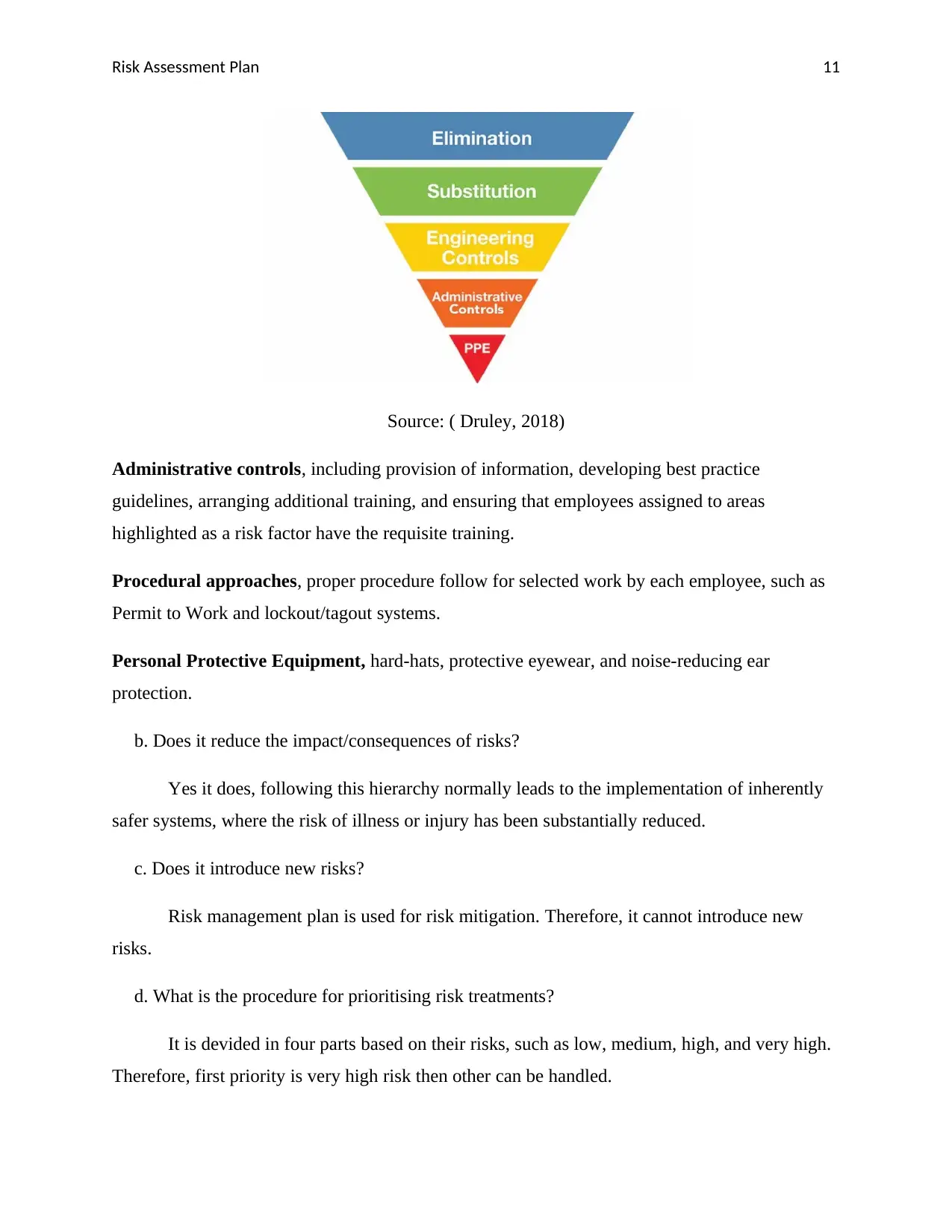
Risk Assessment Plan 11
Source: ( Druley, 2018)
Administrative controls, including provision of information, developing best practice
guidelines, arranging additional training, and ensuring that employees assigned to areas
highlighted as a risk factor have the requisite training.
Procedural approaches, proper procedure follow for selected work by each employee, such as
Permit to Work and lockout/tagout systems.
Personal Protective Equipment, hard-hats, protective eyewear, and noise-reducing ear
protection.
b. Does it reduce the impact/consequences of risks?
Yes it does, following this hierarchy normally leads to the implementation of inherently
safer systems, where the risk of illness or injury has been substantially reduced.
c. Does it introduce new risks?
Risk management plan is used for risk mitigation. Therefore, it cannot introduce new
risks.
d. What is the procedure for prioritising risk treatments?
It is devided in four parts based on their risks, such as low, medium, high, and very high.
Therefore, first priority is very high risk then other can be handled.
Source: ( Druley, 2018)
Administrative controls, including provision of information, developing best practice
guidelines, arranging additional training, and ensuring that employees assigned to areas
highlighted as a risk factor have the requisite training.
Procedural approaches, proper procedure follow for selected work by each employee, such as
Permit to Work and lockout/tagout systems.
Personal Protective Equipment, hard-hats, protective eyewear, and noise-reducing ear
protection.
b. Does it reduce the impact/consequences of risks?
Yes it does, following this hierarchy normally leads to the implementation of inherently
safer systems, where the risk of illness or injury has been substantially reduced.
c. Does it introduce new risks?
Risk management plan is used for risk mitigation. Therefore, it cannot introduce new
risks.
d. What is the procedure for prioritising risk treatments?
It is devided in four parts based on their risks, such as low, medium, high, and very high.
Therefore, first priority is very high risk then other can be handled.
⊘ This is a preview!⊘
Do you want full access?
Subscribe today to unlock all pages.

Trusted by 1+ million students worldwide
1 out of 19
Related Documents
Your All-in-One AI-Powered Toolkit for Academic Success.
+13062052269
info@desklib.com
Available 24*7 on WhatsApp / Email
![[object Object]](/_next/static/media/star-bottom.7253800d.svg)
Unlock your academic potential
Copyright © 2020–2025 A2Z Services. All Rights Reserved. Developed and managed by ZUCOL.





